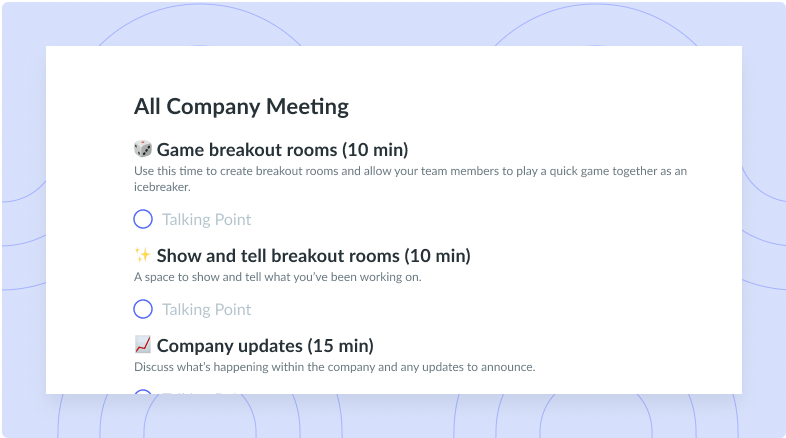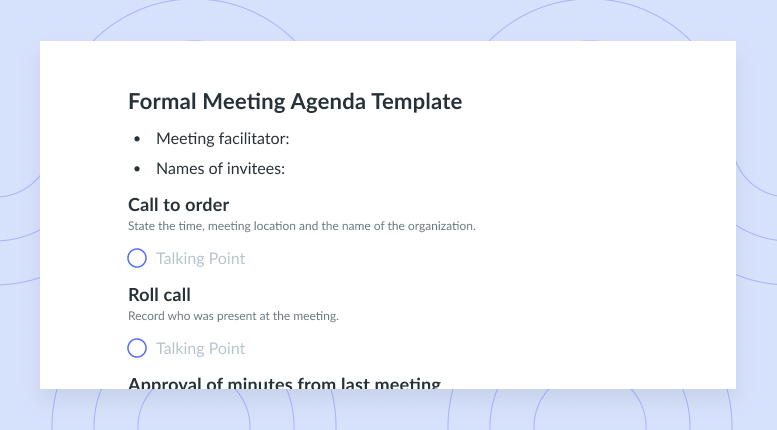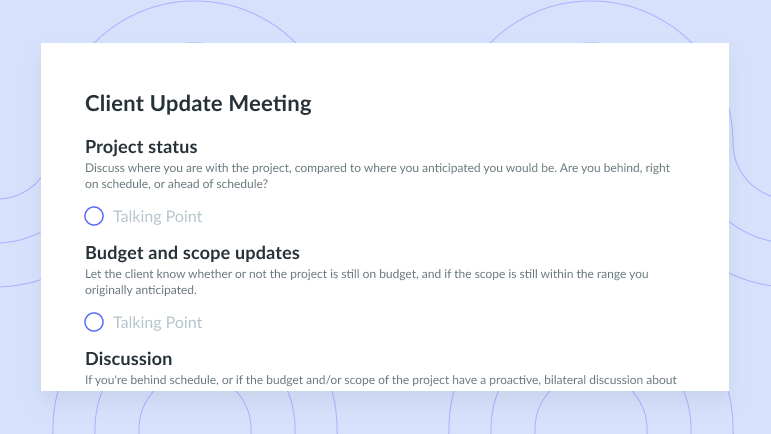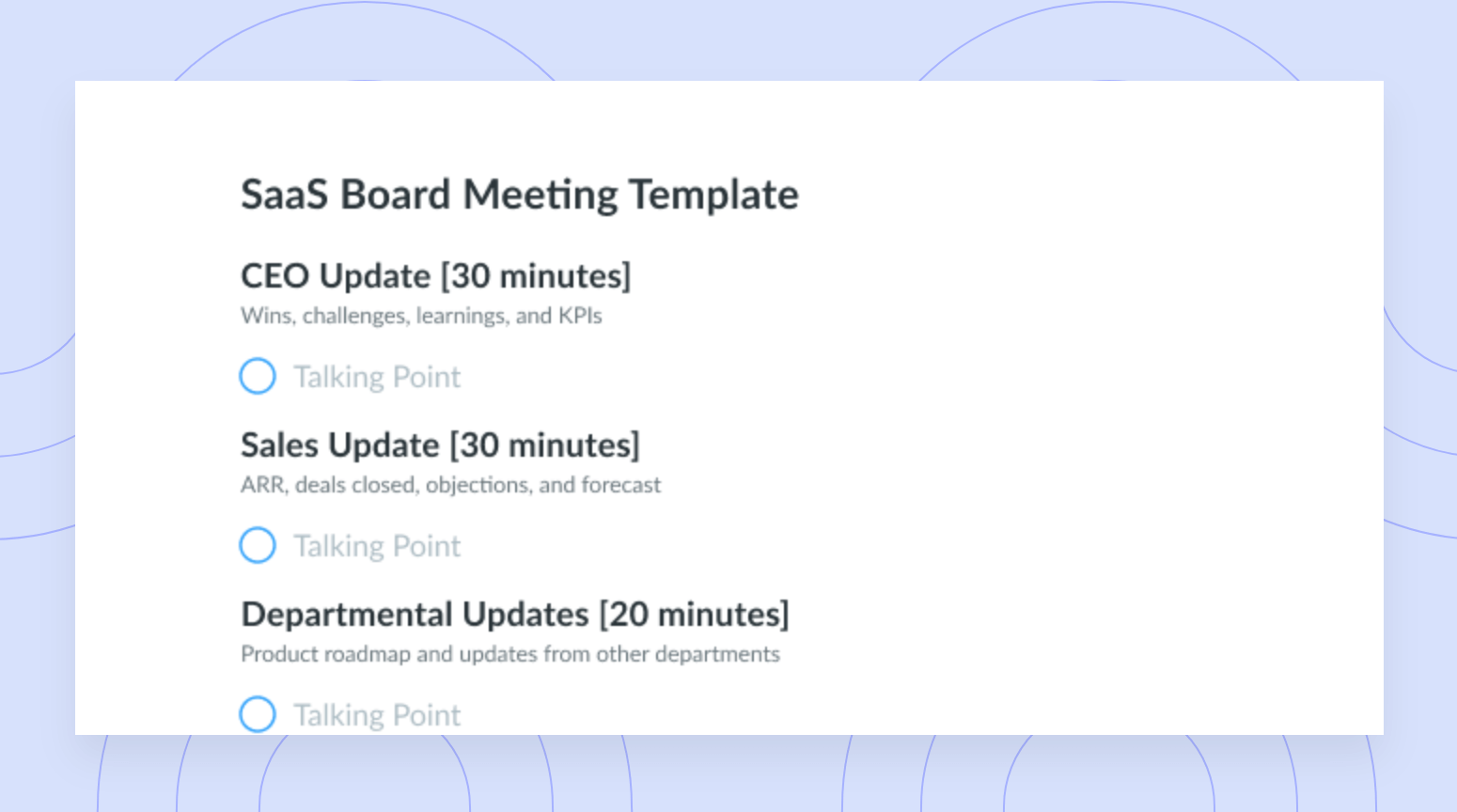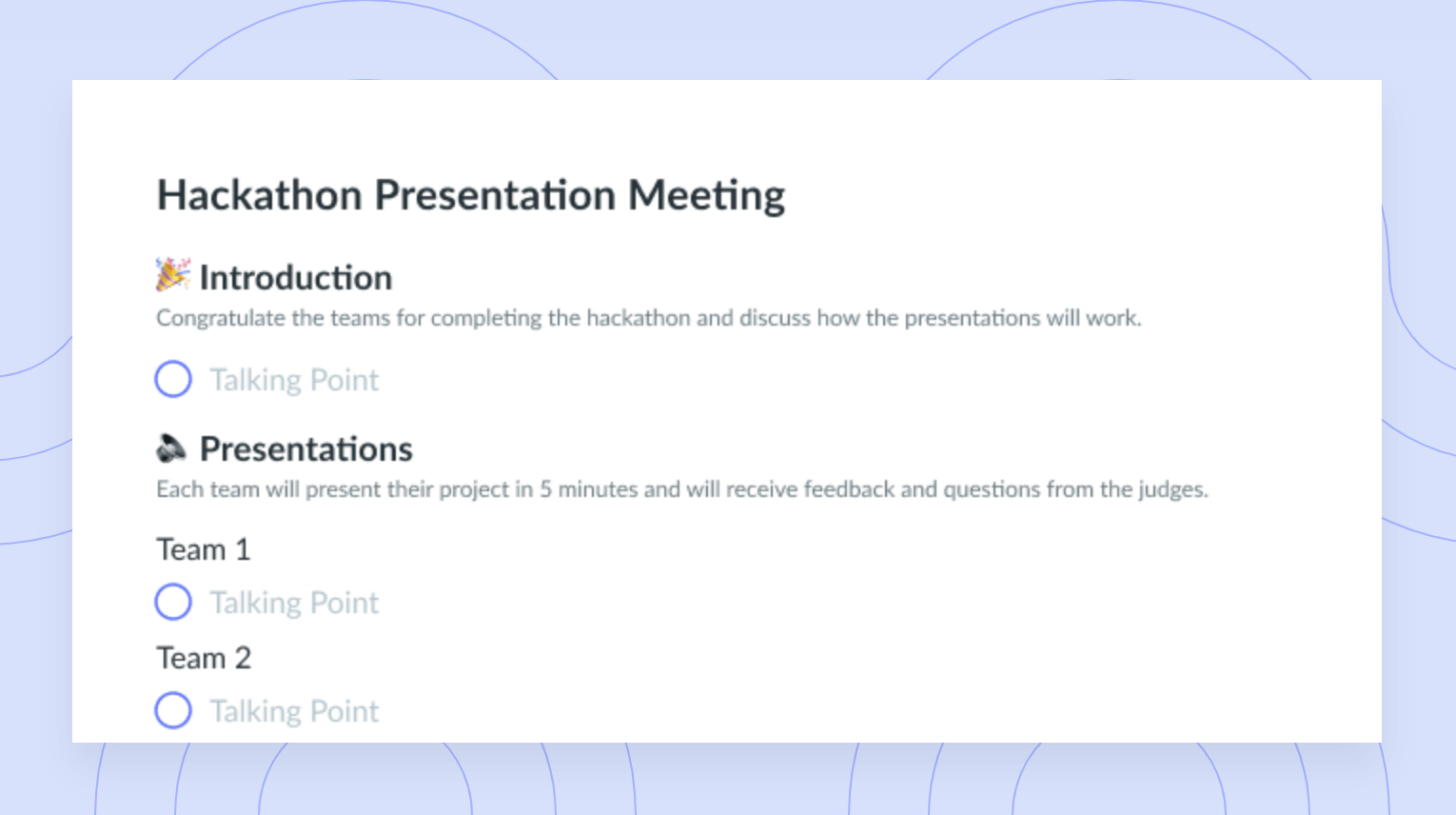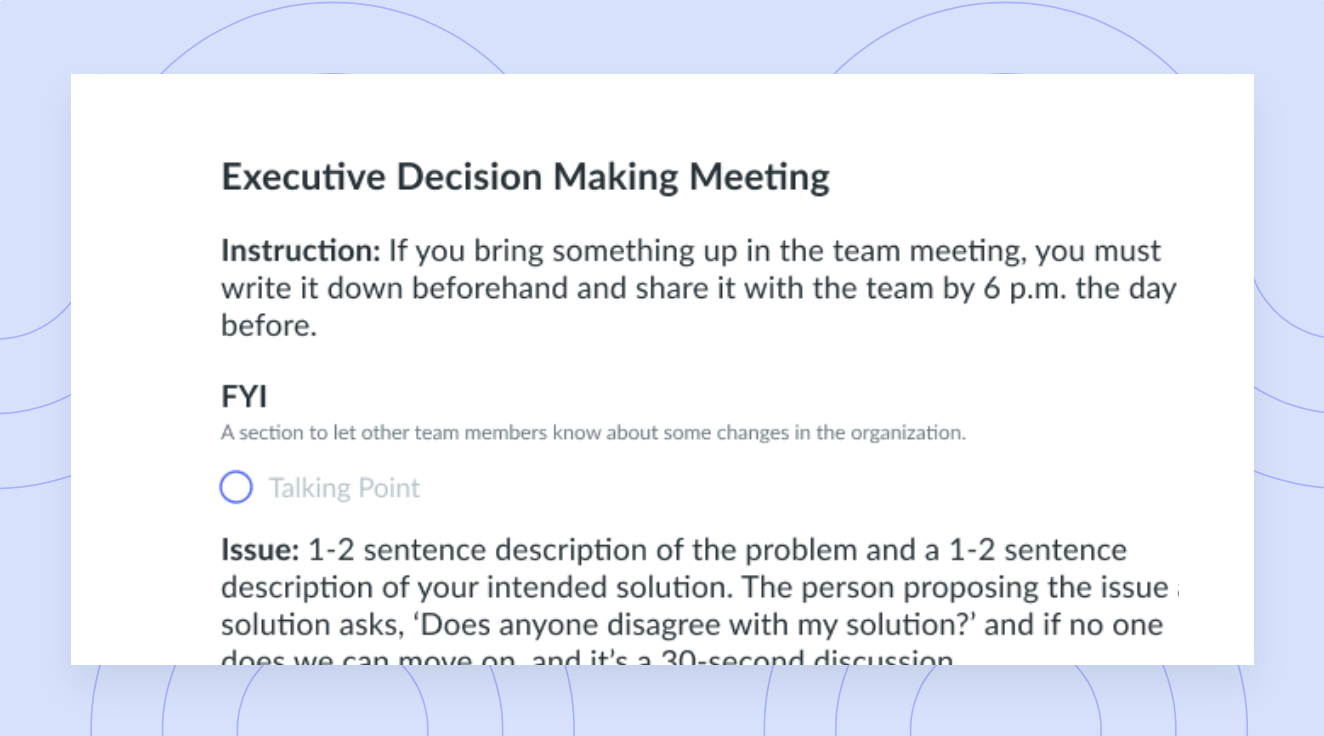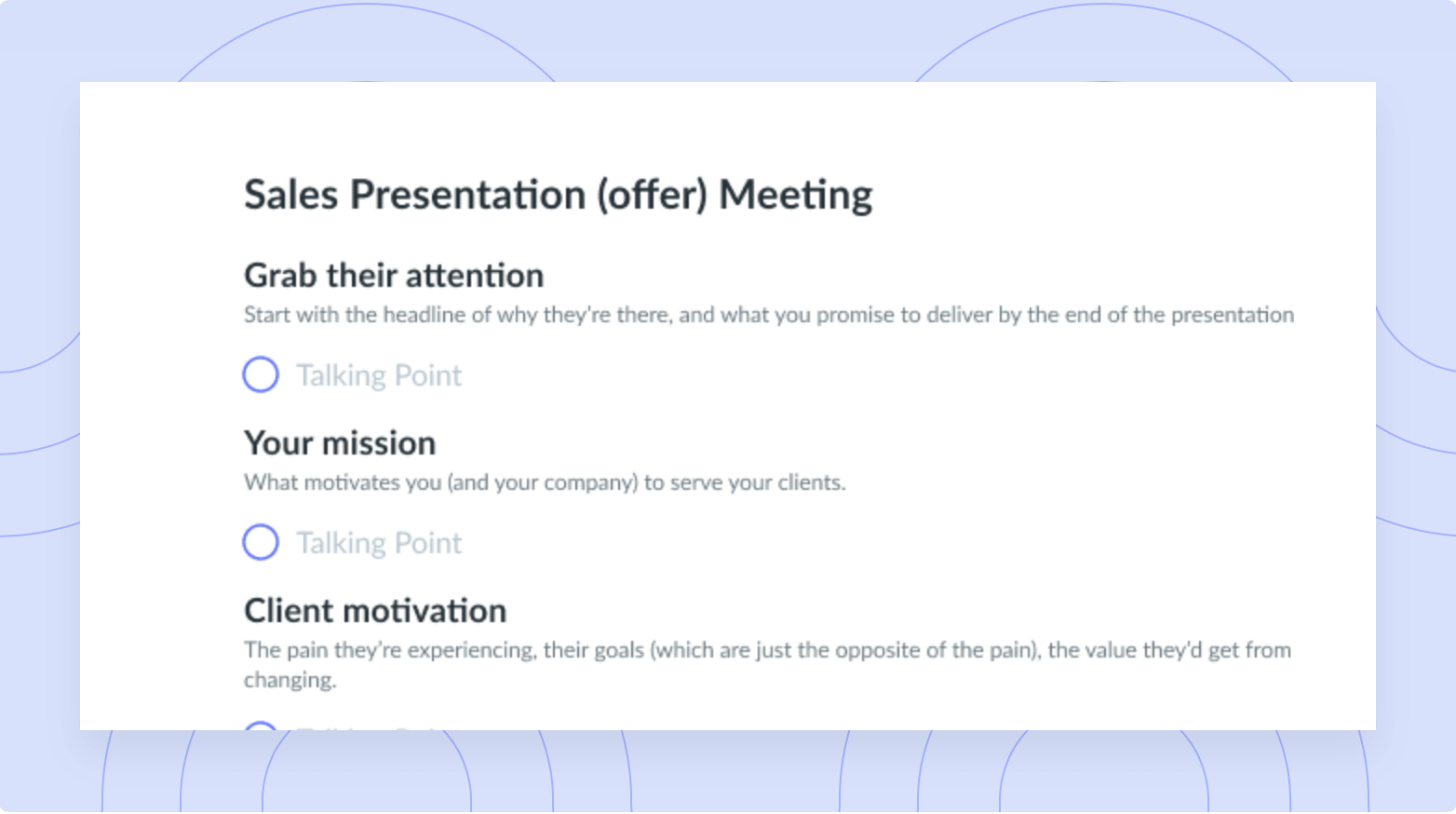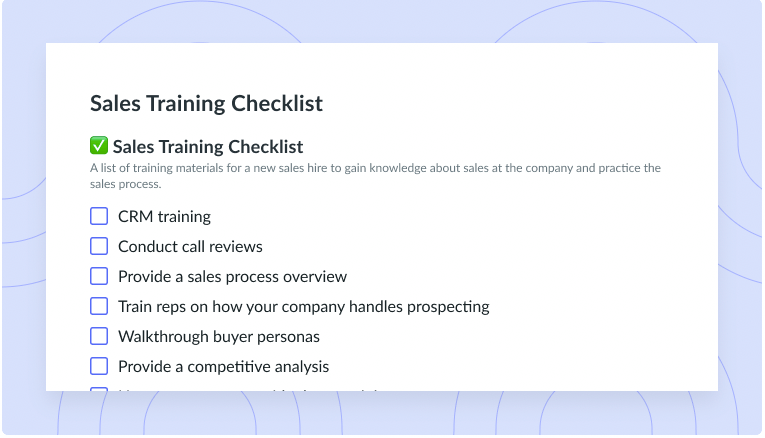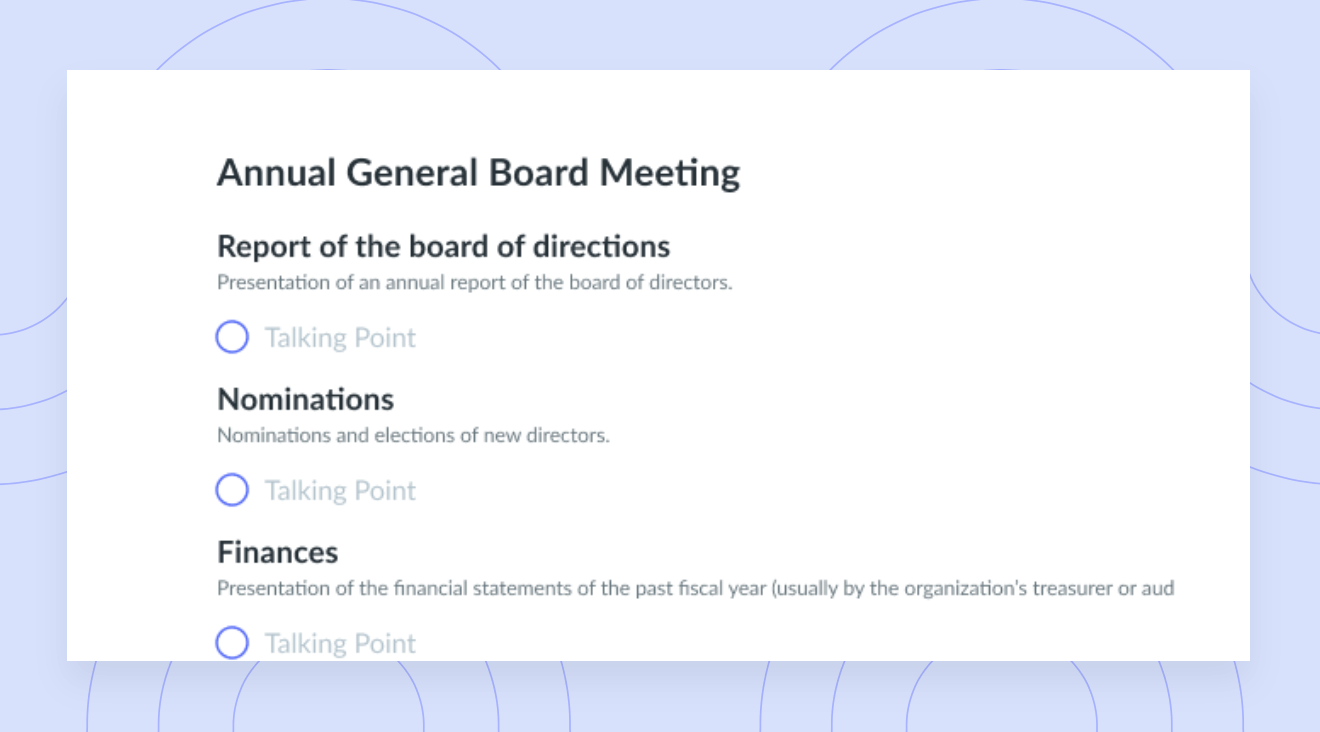How to Give a Meeting Presentation Like a Pro
Giving a meeting presentation might seem daunting, but taking time to prepare and practice can take your confidence to new heights. Try out these tips!
Nothing induces a yawn quite like someone monotonously reading information from slides. If this is you, then you might be dragging your team through meeting presentations that just don’t get points across in impactful ways. There’s a better way — or more accurately, ways — to do it. This article is your guide to confidently giving a powerful presentation that gets the point across while engaging your team.
- What are the different types of presentations?
- How to prepare for a meeting presentation
- How should you begin a meeting presentation?
- What you should do during your presentation
- Ways to wrap up your presentation
- 7 tips to have the best meeting presentation
What are the different types of presentations?
Think about the reasons why you might call a meeting. You could be sharing project updates, encouraging your team after an exhausting project, or sharing important information about new company policies. Each of these meetings calls for a different type of presentation, but here’s the catch: The best practices for meeting presentations remain the same. We’ll get to those in a moment, but first, below are some presentation types you should get to know.
1 Informative
Informative presentations educate, update, or advise your team. You’re basically laying a foundation upon which your team can do the best possible job. Some potential occasions for informative presentations include introducing a new time tracking system or explaining how to use a new software platform.
During an informative meeting, you might display examples, comparisons, or graphs. But that’s not always the most fun (okay, maybe it’s never the most fun). Simplify complex information by playing games, including a video, or pursuing other ways to add some excitement to your presentation.

Pro tip
Use a meeting management tool like Fellow to prepare for your presentation and have all your notes in one place.
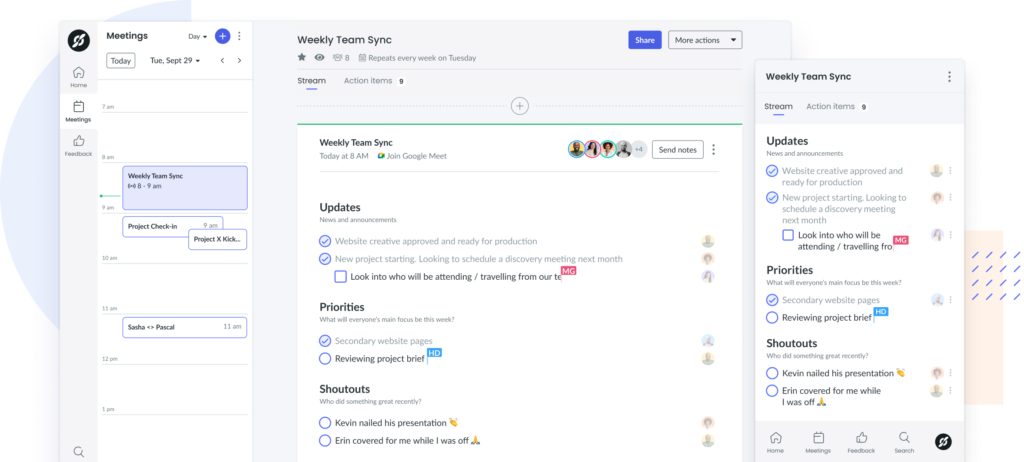
2 Instructive
During instructive presentations, you get to play teacher. You’ll give your team detailed directions on how to reach collective and company goals. Think of them like a manual: They should tell your team how to use their tools to get the job done. But be sure to make them more exciting than manuals! Interactive, hands-on lessons can help make a cut and dry subject more engaging for your team.
3 Persuasive
Persuasive presentations convince attendees to adopt a viewpoint or agree with a proposed action plan. When you lead a persuasive meeting, you’ll typically provide anecdotes and rich details to engage listeners’ emotions. There’s really no better way to connect people with an argument – everyone loves a story. Persuasion is a particularly effective tactic in investor meetings.
4 Motivational
Inspiration and encouragement are the bread and butter of motivational presentations, which get your team excited to take the next steps toward success. These presentations appeal to your team’s emotions and encourage behavioral changes. After a successful motivational meeting, you should feel the energy in the room crank way up as everyone gets on board with your team goals.
5 Decision-making
Decision-making presentations help your team arrive at a decision or solve a problem. They help you make smart choices and prepare alternatives if something goes wrong. And even though making decisions can be tough, preparing your presentation can be easy. Just describe the situation at hand and specify the criteria influencing the decision, then use that all to plot a course of action. And then, act on it!
6 Progress
A progress presentation is all about giving updates. This presentation gets your team up to speed on the status of a project and details your remaining tasks and deadlines. A progress presentation is also a great opportunity to tell your team members how well they’re performing and celebrate their recent wins and accomplishments. Seriously, meetings don’t have to be all business – you do want your team to look forward to them!
How to prepare for a meeting presentation
Preparing for your presentation is just as important as actually presenting. Showing up to your meeting unprepared shows that you’re not prioritizing the meeting – and, more annoyingly, its attendees. A disorganized, repetitive presentation can also quickly lose your listeners’ attention. The below tips counter these challenges and make sure your team walks away educated, inspired, and well-equipped to do amazing things.
- Understand your team. Each team member is responsible for a different task or set of tasks. When you know who’s in the room, you can skip over the “101” of your strategy. This way, you don’t bore (or maybe even insult) your attendees by overexplaining what they already know.
- Prepare in advance. Having a plan keeps your meeting thorough and well-organized. To plan your meeting, gather key information, organize your thoughts, and place those in the presentation. Tailor this important visual aid based on whether you’re meeting in-person, via phone, or by videoconference. You could use a PowerPoint template to create the most beautiful graph is all good and dandy, but you can’t show it on the phone.
- Practice. This advice is age-old, but it’s been proven effective: Practice makes perfect. Seriously – running through your presentation ahead of time helps you memorize the key points you’ll share. This way, you can spend less time going through your memory Rolodex and more time connecting with your team. Practice also boosts your speaking confidence so your delivery is clear.
How should you begin a meeting presentation?
Eight seconds. That’s how much time you have to grab your team members’ attention. That’s it. That’s all. So clearly, your presentation’s introduction needs to spark your listeners’ interest. These ideas can quickly captivate your team’s attention.
- Tell a story. The human brain is wired to enjoy stories. Vibrant, compelling storytelling draws your team’s attention and helps listeners relate to your ideas. Start your presentation by captivating your team members’ emotions to set the tone for your presentation.
- Ask a question. Asking your team an open-ended question immediately invites them to participate in your presentation. Your team members’ answers can shed light on their viewpoints, and then, you can tailor your presentation accordingly.
- Use a short icebreaker activity. Icebreakers are a tried-and-true way to get your team engaged and encourage their participation. Whether in the form of questions or a quick game, icebreakers can get everyone pumped and ready to go.
What you should do during your meeting presentation
Once you’ve finished preparing, approach your presentation as a listener. If you don’t find your presentation interesting, neither will your team members.
Your presentation should do more than… well, present. Instead, show your listeners why they should care about your topic, and convey the information in ways that will get their attention. Consider the following tips.
- Engage your team. Appealing to the senses is a great start. Doing so both tugs at your listeners’ heartstrings and helps them retain key information. For example, use visual aids and colorful charts to appeal to sight. Engage listeners’ sense of touch by using props. Auditory examples include speaking enthusiastically and telling thought-provoking stories.
- Make eye contact. Reading directly from your notes or presentation can distance you from your listeners. Use your notes as a reference, and instead, focus on connecting with your listeners as you would during a normal conversation.
- Do quick check-ups. Checking in with your team throughout your presentation lets you gauge your team members’ attention and interest. Ask a quick question or solicit feedback about something you just discussed. If you don’t get much of a response, you’ll know attention and interest are low. And then, it’s on you to change things up and get all eyes back on you.
- Create space for questions. Don’t spend your entire presentation going through information. Instead, allow time for your listeners to ask questions. This way, you can further discuss points they don’t understand or address any concerns.
Ways to wrap up your presentation
You had an exciting start and a thorough, engaging, presentation. Now, it’s time to seal the deal. Close things out with a brief summary and list some key takeaways. To give your presentation a memorable closing:
- End on a positive note. Thank your team for listening and participating. Use a call to action to further motivate your team. Giving your presentation a positive ending can hint at what you’ve set up your team members to achieve. And that prospect is always exciting.
- Talk about what’s next. Don’t let the momentum end when your presentation does. Use meeting action items to show your listeners how to follow through on everything you’ve discussed. Assign your team members specific responsibilities, and explain any workflow or task changes stemming from your meeting.
7 tips and tricks to have the best meeting presentation
You now have the tools and knowledge to prepare an engaging presentation! But before it’s time to get on the podium (or just in front of the conference table), keep these tips in mind.
- Have a logical structure.
- Slow down.
- Make it interactive.
- Glance at the clock.
- Create natural segues.
- Build your confidence.
- Let your personality shine through.
1 Have a logical structure.
A scattered presentation can easily lose your team’s attention. Facts and demonstrations should be a part of the structure where they won’t interrupt the natural flow of your presentation. Exclude examples or points that don’t directly contribute to your presentation.
2 Slow down.
Speakers tend to talk faster when they’re presenting – public speaking can be nerve-wracking! But rushing through your presentation can cause your team to miss key points and feel confused. Talk slower than normal – what seems slow to you is likely a perfect speed for your listeners.
3 Make it interactive.
Use questions, activities, and discussions to encourage team participation. You’ll keep listeners engaged and more receptive to your ideas.
4 Glance at the clock.
Occasionally checking the time can prevent you from lingering on certain points too long. This way, you can get through your full presentation without rushing or going too long.
5 Create natural segues.
Organize your presentation in a way that links ideas together and creates a smooth flow between points. Think of your presentation like a movie: There should be a transition from one “scene” to the next. This way, your team members can more easily follow along.
6 Build your confidence.
Practice, practice, practice. Imagine your living room is your meeting space, and practice giving your presentation aloud with no one present. The more you practice and present, the more confident you’ll become. And sure, it’s understandable to feel nervous before a presentation. But just trust yourself! You’ll do great.
7 Let your personality shine through.
Leave room for you in your presentation. If quirky jokes are your specialty, don’t hesitate to add them (where appropriate, and with discretion) into your presentation. If a personal story might perfectly explain a concept, there’s room for that too.
Presenting like a pro
Giving a meeting presentation might seem daunting, but taking time to prepare and practice can take your confidence to new heights. The tips in this article can help you level up your presentation skills and keep your listeners participating the entire time. And for every type of meeting presentation, Fellow has many resources to help you create meeting agendas, improve team engagement, and receive useful feedback from your employees.

![How to Take the Best Meeting Notes: 8 Tips [+ Free Templates]](https://fellow.app/wp-content/uploads/2022/03/Tips-for-Taking-Meeting-Notes-That-Make-Sense.jpg)







